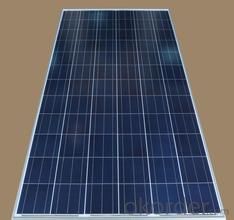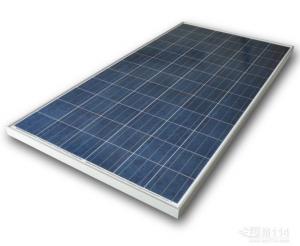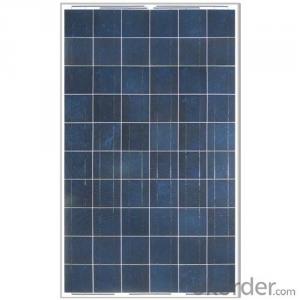Juno Solar Panels Poly 270W with TUV, IEC, CE
- Loading Port:
- Ningbo
- Payment Terms:
- TT or LC
- Min Order Qty:
- -
- Supply Capability:
- 600MW Annual year watt/month
OKorder Service Pledge
OKorder Financial Service
You Might Also Like
Competitive Prices 270w Poly Solar Panels from China Manufacturer
Solar Panel 270w with Good Quality and Warranty
Mechanical Characteristics
Cell Type | Poly Crystalline 156×156mm(6 inch) |
No. of Cells | 72(6×12) |
Dimension | 1950×992×50mm |
Weight | 23kg |
Component element
Front Glass | 3.2mm, High Transmission, Low Iron, Tempered Glass |
Frame | Anodized Aluminum Alloy Type 6063-T5 |
Junction Box | IP 65 Rated (Black) |
Output Cables | TUV 1×4mm2, length:900mm |
Connector | MC4(UV resistance and self-locking/IP67) |
Encapsulation Material | EVA(0.50±0.03mm thickness) |
Back Foil | White TPT(0.32±0.03mm thickness) |
Fixing Adhesive | Silicone Sealant(White) |
Specifications
Module Type | NBJ-270P | NBJ-280P | NBJ-290P | NBJ-300P |
Maximum Power at STC (Pmax) | 270Wp | 280Wp | 290Wp | 300Wp |
Maximum Power Voltage (Vmp) | 36.21V | 36.38V | 36.50V | 36.60V |
Maximum Power Current (Imp) | 7.46A | 7.61A | 7.95A | 8.20A |
Open-circuit Voltage (Voc) | 43.50V | 43.70V | 43.95V | 44.30V |
Short-circuit Current (Isc) | 7.98A | 8.24A | 8.50A | 8.77A |
Cell Efficiency (%) | 15.7% | 16.3% | 16.9% | 17.2% |
Module Efficiency (%) | 14% | 14.5% | 15.0% | 15.5% |
Operating Temperature( °C ) | -40°C ~+90°C | |||
Maximum System Voltage(V) | DC 1000V(TUV) / DC600V(UL) | |||
Maximum Rated Current Series(A) | 15A | |||
Power Tolerance | 0~+3% | |||
Temperature Coefficients of Pmax | (-0.45±0.05)%/°C | |||
Temperature Coefficients of Voc | (0.05±0.01) %/°C | |||
Temperature Coefficients of Isc | (-0.35±0.02)%/°C | |||
NOTC(°C ) | (47±2)°C | |||
STC: Irradiance 1000W/M2 Module Temperature: 25°C AM=1.5
Warranty
Warranty | 10-year warranty on product material and processing technology |
Industry power output warranty: 90% in 12 years, 80% in 25 years |
Packing Configuration
Q’ty/Pallet, | 1×20’ft | 1×40’GP | 1×40’HQ |
Pallet Q’ty | 5pallets | 11pallets | 11pallets |
Q’ty/Container | 200pcs | 440pcs | 495pcs |
Package


FAQ
I. Will you focus on the safety of the goods during transportation?
Yes, Safety of the cargo is the primary element that we would consider on transportation.
II..How would guarantee the quality will meet the requirements of your clients?
Before shipment, we will have inspection for each batch of goods.
III..What certificates do you have?
IEC,UL,TUV,CSA,etc.
IV..Can you do OEM according to clients’ requirements?
Yes, we have our own brand while we can provide OEM service.
- Q: Why would someone use a solar panel? Does it have to do with the economy right now, global warming, or what?
- It turns energy from the Sun directly into usable electricity and is very useful if you are far away from the power grid or want an alternative electricity source. Since energy prices must steadily rise and Solar cells are getting cheaper, it is likely that in several years Solar panels will provide electricity as cheaply as the big power companies who maintain our power grid.
- Q: Can solar panels be installed on camping sites?
- Yes, solar panels can be installed on camping sites. They are a great renewable energy option for powering small electronic devices, lighting, and charging batteries while camping.
- Q: Are solar panels easy to maintain?
- Solar panels are generally easy to maintain as they have no moving parts and require minimal attention. Regular cleaning to remove dust and debris, as well as occasional inspection for any damage or shading, is usually sufficient to ensure optimal performance.
- Q: Can solar panels be installed on the ground?
- Yes, solar panels can be installed on the ground. Ground-mounted solar panels are a popular option for residential, commercial, and utility-scale solar installations. They are typically mounted on racks or frames that are secured to the ground, allowing the panels to capture sunlight and convert it into electricity. Ground-mounted solar panels are often preferred when there is limited roof space or for installations that require optimal positioning and easy maintenance.
- Q: If you were to be asked to write a material(s) report on either -solar panelsor -aircraft fuselageWhich would you choose?well i was asked to choose between these two,so i guess that if i choose what the majority wouldn't, i might just score a little bit higher,what do you think?if you are the lecturer you would want something different right?
- Solar Panels. Solar panels is a generic term for any semiconductor that converts solar energy to electrical energy. However there many different kinds of solar panels and constructed in different ways from different materials. There is the generic polysilicon solar panels for residential installation on one end of the spectrum. On the other end are very high efficiency (and expensive) solar cells used on the Mars Orbiter that are constructed of so called triple junction GaAs/Ge solar cells. In addition there are also the thin film solar cells that are being researched that use Cadmium Telluride (CdTe) to form junctions and make very efficient cells on very thin substrates. I would say that research into materials that can be used for solar cells is one of the hottest research fields right now. (That being said, I really did enjoy Airframe by Micheal Crithon. Whenever I'm in a plane during bad weather I always thing of the engineers that designed the plane... what assumptions did they make... what tradeoffs did they make... )
- Q: Can solar panels be installed on churches or religious institutions?
- Yes, solar panels can be installed on churches or religious institutions. In fact, many religious institutions have embraced solar energy as a way to reduce their carbon footprint and promote environmental sustainability. Installing solar panels on churches not only helps them save on energy costs but also serves as a symbol of their commitment to caring for the planet and being good stewards of the environment.
- Q: Can solar panels be installed on multi-story buildings?
- Yes, solar panels can be installed on multi-story buildings. In fact, multi-story buildings are often ideal for solar panel installations as they have a larger surface area to accommodate more panels. Additionally, the height of the building can provide better exposure to sunlight throughout the day.
- Q: Can solar panels be installed on a pole or ground mount?
- Yes, solar panels can be installed on both poles and ground mounts. Pole mounts are often used when there is limited space on the ground or when panels need to be elevated for better sunlight exposure. Ground mounts, on the other hand, are ideal for larger installations or when the ground is more suitable for anchoring. Both options offer flexibility in terms of placement and can effectively harness solar energy.
- Q: Why is it nessicary, with today's economy in the postion it's currently in, to use renewable energy sources; like solar panels?
- well you can save money over time even though the initial costs are quite high. Solar PV will allow you to not be subject to electrical rate inflation, which is averaging at about 6% per year. Solar also is better for the environment, so it gives you piece of mind.
- Q: how to build a solar panel
- Build okorder
Send your message to us
Juno Solar Panels Poly 270W with TUV, IEC, CE
- Loading Port:
- Ningbo
- Payment Terms:
- TT or LC
- Min Order Qty:
- -
- Supply Capability:
- 600MW Annual year watt/month
OKorder Service Pledge
OKorder Financial Service
Similar products
Hot products
Hot Searches
Related keywords




























